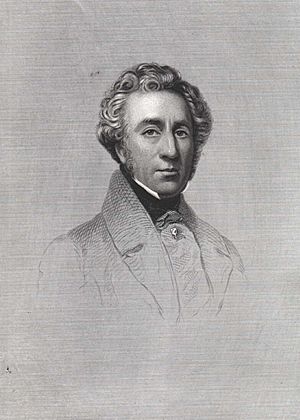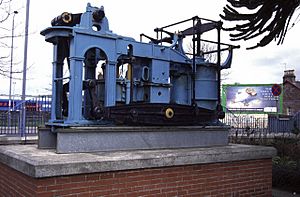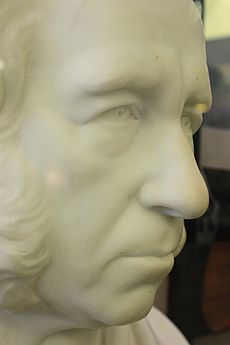Robert Napier (engineer) facts for kids
Robert Napier (born June 21, 1791 – died June 23, 1876) was a Scottish engineer. He was famous for his work in building ships and their engines in the Clyde area of Scotland.
Contents
Early Life and Training
Robert Napier was born in Dumbarton during the Industrial Revolution. His family had a history of working with metal and building things. His father, James, was a skilled craftsman.
Robert went to the local school and loved drawing. He also became interested in his family's business. When he was 16, he almost got forced to join the navy during the Napoleonic Wars. To stop this, his father signed a special agreement, making Robert immune to joining the military.
Robert trained with his father for five years. After that, he moved to Edinburgh. There, he worked for Robert Stevenson, who built the famous Bell Rock Lighthouse.
Starting His Own Business
In 1815, Robert Napier started his own business. He joined a group for metalworkers in Glasgow. In 1841, he brought his sons, James and John, into the company. The business then became known as Robert Napier and Sons.
Building Ships and Engines
In 1823, Robert Napier got a job to build a steam engine for a paddle steamer called Leven. The engine was so good that it was later used in another ship, the Queen of Beauty. The Leven engine was his first, and you can still see it today at the Scottish Maritime Museum in Dumbarton.
By 1827, Napier was known for building fast engines. His engines were in the two quickest ships at a big boat race that year. This helped his reputation grow. He also worked with Thomas Assheton Smith on ship designs. He built several steam yachts for him, starting with the Menai. In 1828, he opened his own factory in Glasgow called the Vulcan Foundry.
Many famous Scottish shipbuilders learned their skills from Napier. This includes James and George Thomson, who started the J & G Thomson shipyard. Also, John Elder, who founded the Fairfield Shipbuilding and Engineering Company, trained with him.
Napier kept building steamship engines, even for large ships that traveled across oceans. In 1835, he won a contract to build an engine for the Berenice. This ship, built by his cousin David Napier, used Robert's engine. It was much faster than its sister ship, beating it to India by 18 days.
In 1838, the British Navy asked Napier to build engines for two of their ships. After these, they stopped ordering. When Napier asked why, it turned out his engines were cheaper and more reliable than others. After that, he became the Navy's main engine builder.
Working with Cunard Line
Napier's biggest success came from working with Samuel Cunard. He helped Cunard and others start the British and North American Royal Mail Steam Packet Company. It's thought that Napier chose the famous red and black colors for the Cunard ship funnels. He had used these colors on his earlier ships.
In 1841, Napier expanded his company. He added a shipyard in Govan and a steelworks called Parkhead Forge. In 1843, they built their first ship, the Vanguard. He also got a contract to build iron ships for the Royal Navy. These included the Jackal, Lizard, and Bloodhound. They were the first iron ships in the Royal Navy. Napier even let naval officers visit his shipyard to learn about these new vessels.
The Parkhead Forge was later bought by another company in 1886. Napier's shipyard in Govan was also sold and eventually closed in 1962. The Parkhead Forge closed in 1976.
Awards and Recognition
Robert Napier received many honors for his work:
- In 1851, he was a judge at the Crystal Palace Exhibition.
- He was made a Chevalier (Knight) of the Légion d'honneur by Napoleon III of France.
- In 1863, he became the President of the Institution of Mechanical Engineers.
- In 1867, Napoleon III made him a Royal Commissioner for the Paris Exhibition.
- In 1868, he was made a Commander of the Most Ancient Order of Dannebrog by King Christian IX of Denmark. Napier's shipyard had built a battleship for the Danish Navy in 1863.
- In 2014, he was added to the Scottish Engineering Hall of Fame.
Love for Art
Robert Napier always loved art. He built his home in Shandon, by the Gareloch, to hold his large art collection. It included paintings by famous artists like Henry Raeburn and Horatio McCulloch, as well as art from Dutch, French, and Italian masters.
Later Life and Death
In 1875, his wife of 57 years, Isabella, passed away. Robert Napier became very ill shortly after and died the next year, in 1876. He is buried in the Parish Kirkyard in Dumbarton.
See also
- Robert D. Napier, another engineer from the same time with a similar name.
Literature
- James Napier: Life of Robert Napier of West Shandon. Publisher: William Blackwood and sons, Edinburgh and London 1904
- APPENDIX – I. Copy of original contract for first Cunard steamers, 18 March 1839 in: Life of Robert Napier of West Shandon. By James Napier
- APPENDIX – II. Particulars of some of the leading contracts executed by Mr. Napier
| Professional and academic associations | ||
|---|---|---|
| Preceded by William George Armstrong |
President of the Institution of Mechanical Engineers 1863–1865 |
Succeeded by Joseph Whitworth |




